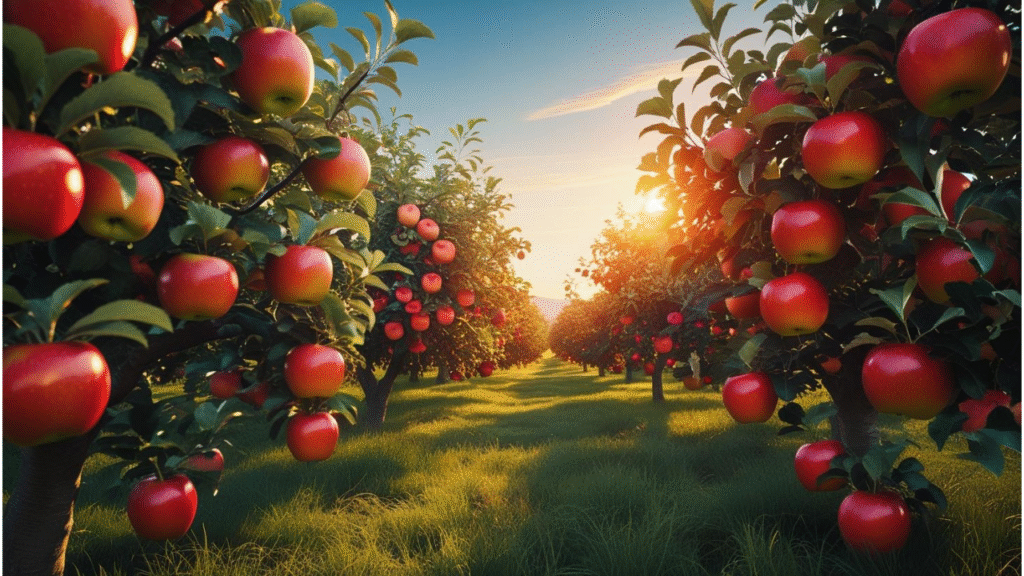
How to Grow and Care for a Paradise Apple Tree: Expert Tips for a Thriving Orchard
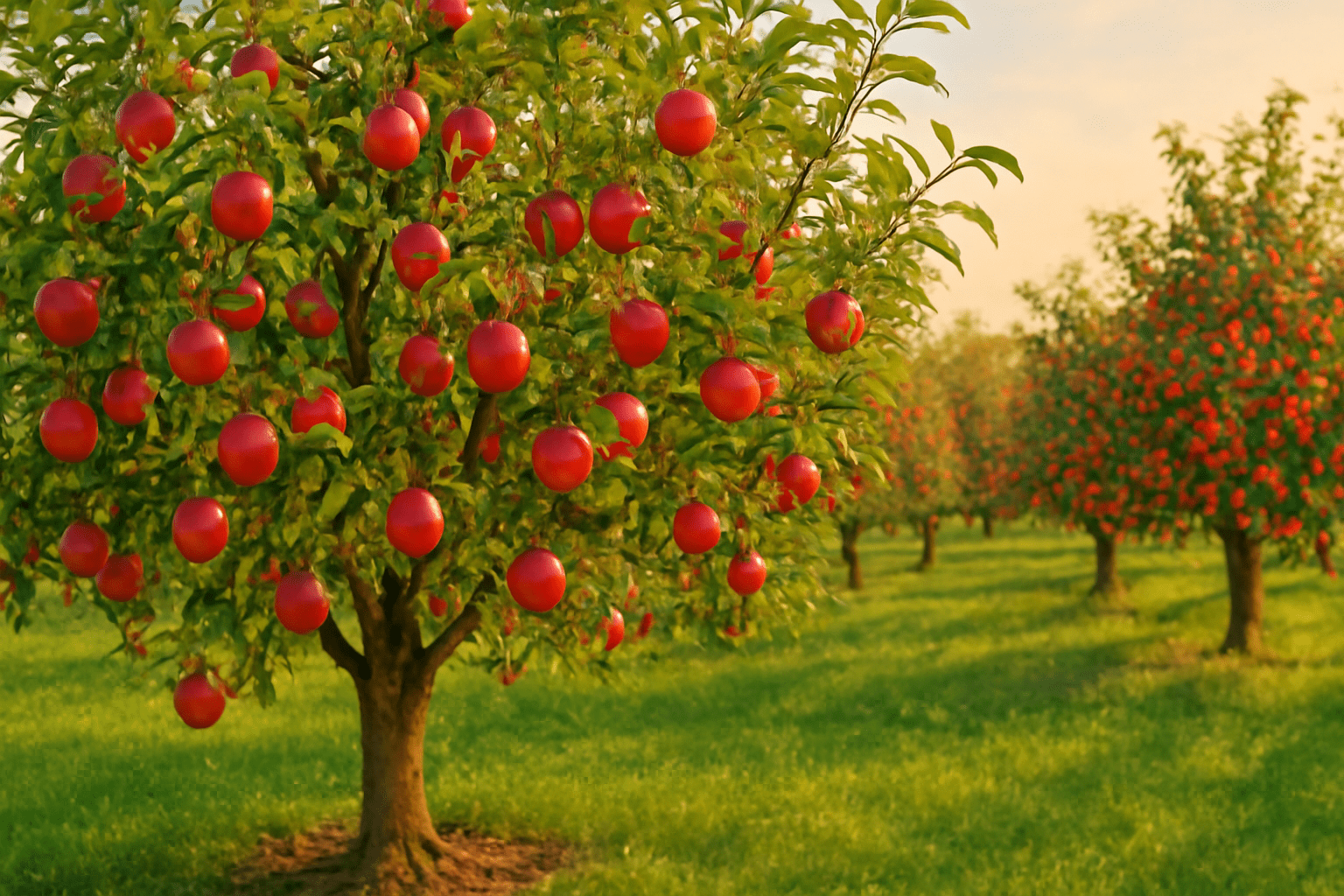
Table of Contents
Toggle🍏 Understanding the Paradise Apple Tree: Key Characteristics 🍏
The paradise apple tree 🌳 is a charming and rewarding fruit tree 🍏 that brings both beauty 🌸 and delicious apples 🍎 to your garden 🌿. But before you start planting 🌱, it’s essential to understand its key characteristics to ensure success ✅. Here’s a quick breakdown of what you should know:
🌳 Origin & History 🌳
The paradise apple tree 🌳 is a variety of ornamental apple tree 🍏, often grown for its attractive fruit 🍎 and hardy nature 💪. It originated as a hybrid of different apple varieties 🍏, designed to thrive 🌱 in various climates 🌍. With its roots in colder regions ❄️, it’s a perfect choice for gardeners 🌱 in USDA hardiness zones 4-8.🍏 Appearance 🍏
The paradise apple tree 🌳 grows to a manageable size 🌿—usually between 8 to 15 feet tall 📏. Its branches 🌿 are elegant and spread wide, perfect for providing shade 🌞 in the garden 🌿. The tree boasts glossy green leaves 🍃, and in spring 🌸, it produces delicate white to pinkish blossoms 🌺 that give way to the small, round apples 🍏. These apples 🍎 start off green 🟢 but turn a vibrant red 🔴 as they ripen, making the tree 🌳 a visually stunning addition to any landscape 🌄.🍎 Fruit Characteristics 🍎
The apples 🍎 of the paradise apple tree 🌳 are known for their unique, sweet-tart flavor 🍋. They are small in size, about 1-2 inches in diameter 📏, and are often used for making jams 🍯, jellies 🍇, or fresh eating 🍽️. The flesh 🍏 is crisp and juicy 💦, making it a favorite for those who enjoy a bit of zing in their fruit 🍎.🌞 Climate & Hardiness Zones 🌞
One of the reasons the paradise apple tree 🌳 is so popular 🌟 is its versatility when it comes to climate 🌍. It thrives 🌱 in USDA zones 4-8, meaning it can tolerate both colder winters ❄️ and warm summers 🌞. This makes it ideal for a wide range of regions across the country 🇺🇸. It also grows well in areas with varying amounts of rainfall 🌧️, though it does best when watered regularly 💧 and properly. By understanding these basic characteristics of the paradise apple tree 🌳, you can better prepare for planting 🌱 and caring for this beautiful, fruitful tree 🍏 in your own garden 🌻. Ready to plant your own paradise apple tree 🌳? Let’s continue exploring the best ways to give it the perfect home! 🌱🌳🌞 Selecting the Right Location for Your Paradise Apple Tree 🌞
Choosing the perfect spot for your paradise apple tree 🌳 is key to ensuring it grows healthy 🌱 and produces a bountiful harvest 🍏. Let’s take a look at the main factors to consider when selecting the right location. 🌟
🌅 Sunlight Requirements: Why Full Sun is Essential for Optimal Fruit Production 🌞
To thrive 🌱, the paradise apple tree 🌳 needs full sun ☀️—at least 6 to 8 hours of direct sunlight per day 🌅. Sunlight helps the tree photosynthesize 🌞, fueling its growth 🌿 and promoting the production of sweet, crisp apples 🍏. Without enough sun 🌞, the tree may become weak 💔 and struggle to bear fruit 🍎. So, make sure to choose a sunny spot 🌞 where your tree can soak up all the sunlight it needs to flourish 🌸.🌱 Soil Type: Best Soil Conditions 🌿
The paradise apple tree 🌳 thrives in well-drained soil 🌱. It prefers slightly acidic to neutral soil 🏞️, with a pH level between 6.0 and 7.0. Good drainage 💧 is important because the tree’s roots don’t like to sit in waterlogged soil. If the soil retains too much water 💦, it can lead to root rot and poor tree health. To improve soil drainage, you can add organic matter like compost 🌾 or plant the tree on a slight mound to ensure proper water flow 🚿.📏 Space Considerations: How Much Space the Tree Needs for Healthy Growth 🌳
While the paradise apple tree 🌳 is relatively compact, it still needs space 🌿 to spread its branches 🌳 and develop a strong root system 🌱. Ideally, plant your tree at least 6 to 10 feet away from any structures 🏠 or other trees 🌳. This gives it plenty of room to grow 🌻 and ensures good airflow 🌬️, which helps prevent fungal diseases 🍄. If you plan to plant more than one tree 🌳, make sure to space them about 10 to 15 feet apart 📏 so they have enough room to grow without competing for sunlight ☀️ or nutrients 🧑🌾.🌳 Avoiding Root Competition: Why You Should Plant Your Tree Away from Other Large Trees or Shrubs 🌿
It’s tempting to plant your paradise apple tree 🌳 near other large trees 🌳 or shrubs 🌿, but it’s crucial to avoid root competition 🌱. Larger trees 🌳, with their extensive root systems, can steal water 💧 and nutrients 🌾 from your apple tree 🍏, making it harder for your tree to establish itself and grow properly. Plant your paradise apple tree 🌳 in an area where it won’t have to compete with other plants 🌿 for resources, ensuring that it has the best chance to thrive 🌱. By selecting the right location 🌿 with the proper sunlight ☀️, soil 🌱, and space 🌳, you’ll set your paradise apple tree 🌳 up for success. Now, let’s get ready to plant 🌱 your tree and give it the perfect environment 🌿 to grow strong and healthy! 🌳🌱 Planting a Paradise Apple Tree: Step-by-Step Guide 🌱
Planting your paradise apple tree 🌳 correctly is essential to ensure healthy growth 🌱 and a fruitful harvest 🍏. Follow this simple, step-by-step guide to give your tree the best start possible. 🌟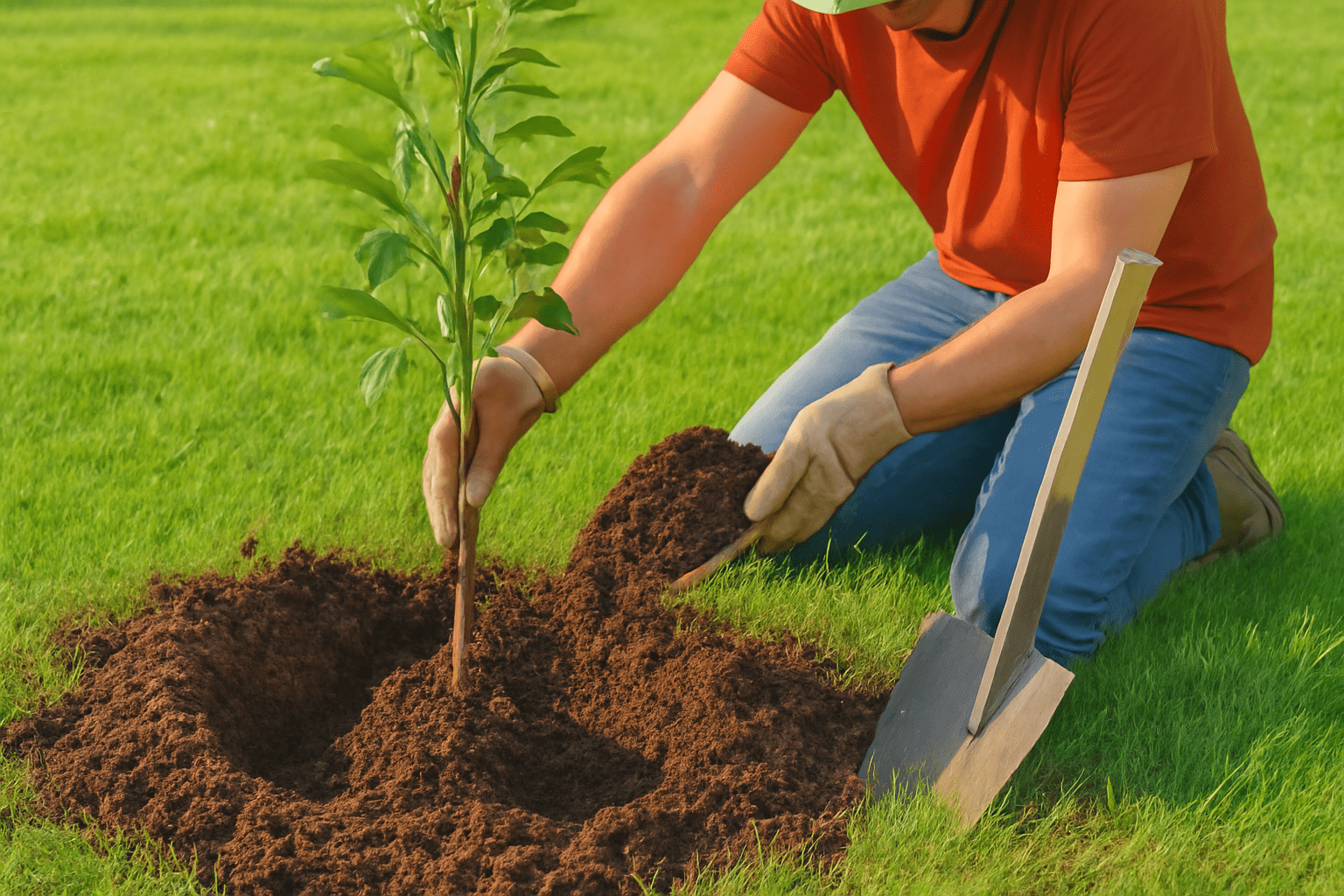
🌷 Choosing the Right Time to Plant: Best Planting Seasons (Early Spring or Fall) 🌞
Timing ⏰ is important when planting your paradise apple tree 🌳. The best times to plant are early spring 🌱 (after the last frost ❄️) or fall 🍂 (before the first frost 🧊). Early spring allows the tree to establish itself before the heat of summer 🌞, while fall planting gives the roots time to grow before winter sets in. Avoid planting in the middle of summer ☀️ when the heat can stress the young tree 🌳.🌿 Preparing the Soil: Testing pH, Improving Soil Fertility, and Tilling the Ground 🌾
Before planting, it’s essential to prepare the soil 🌍 for your tree. Start by testing the soil’s pH ⚖️—the paradise apple tree 🌳 prefers a slightly acidic to neutral pH (between 6.0 and 7.0). If the soil is too acidic or alkaline, you can adjust it with lime or sulfur 🧪 to reach the ideal pH. To improve soil fertility 💪 and drainage 🚿, add organic matter like compost 🌱 or well-rotted manure 🐄. This will help the roots establish themselves more easily and encourage strong growth 🌱. Tilling the soil to a depth of 4-6 inches will help break up compacted soil 🧑🌾 and allow roots to spread more freely.🕳️ Digging the Hole: Ideal Hole Depth and Width for Planting 📏
Next, it’s time to dig the hole 🔨 for your paradise apple tree 🌳. The hole should be about 2-3 times wider than the root ball 🌱 but only slightly deeper. Ideally, the hole should be about 18-24 inches wide and 12-18 inches deep, depending on the size of the tree’s root system. A wider hole allows the roots to spread easily and establish themselves quickly. Avoid digging too deep 🕳️, as planting the tree too low can lead to root rot or other issues ❌. You want the top of the root ball 🌱 to be level with the surrounding soil 🌍.🌳 Proper Planting Depth: How to Position the Root Ball 🌿
When you place the tree 🌳 in the hole, ensure that the root ball 🌱 is sitting at the correct depth. The top of the root ball should be even with the soil level or slightly above it 🌍. Planting the tree too deep can suffocate the roots 🌱 and hinder growth 🚫. If you’re planting a bare-root tree 🌳, gently spread out the roots in the hole 🕳️ to avoid them being bunched up. Make sure the tree is standing straight in the hole 📏 before backfilling with soil 🌍. Be sure not to bury the trunk of the tree! 🌱💧 Watering Immediately After Planting: Why It’s Crucial for Root Establishment 💦
After planting 🌳, water 💧 the tree thoroughly to help the soil settle around the roots and eliminate air pockets. This initial watering helps establish good root-to-soil contact 🤝 and ensures that the tree 🌳 gets the moisture 💧 it needs to start growing. For the first few weeks 🌱, keep the soil around the root ball consistently moist but not soggy 🏞️. Overwatering 💦 can lead to root rot, so it’s essential to find the right balance ⚖️. Proper watering is crucial to getting your paradise apple tree 🌳 off to a strong start 💪. By following these simple steps 🌱, you’ll set your paradise apple tree 🌳 up for long-term success 🎉. Now that you’ve planted your tree 🌳, it’s time to care for it properly 🧑🌾 to ensure healthy growth and abundant apples 🍏 in the future. Stay tuned for tips on watering 💧, fertilizing 🌱, and more! 🌳💧 Watering and Irrigation: Ensuring Healthy Growth 💧
Proper watering is essential to the success of your paradise apple tree 🌳. Whether your tree is a young sapling 🌱 or well-established 🌳, knowing when and how to water 💧 can make all the difference. Let’s explore everything you need to know about watering your tree for optimal health and growth! 🌟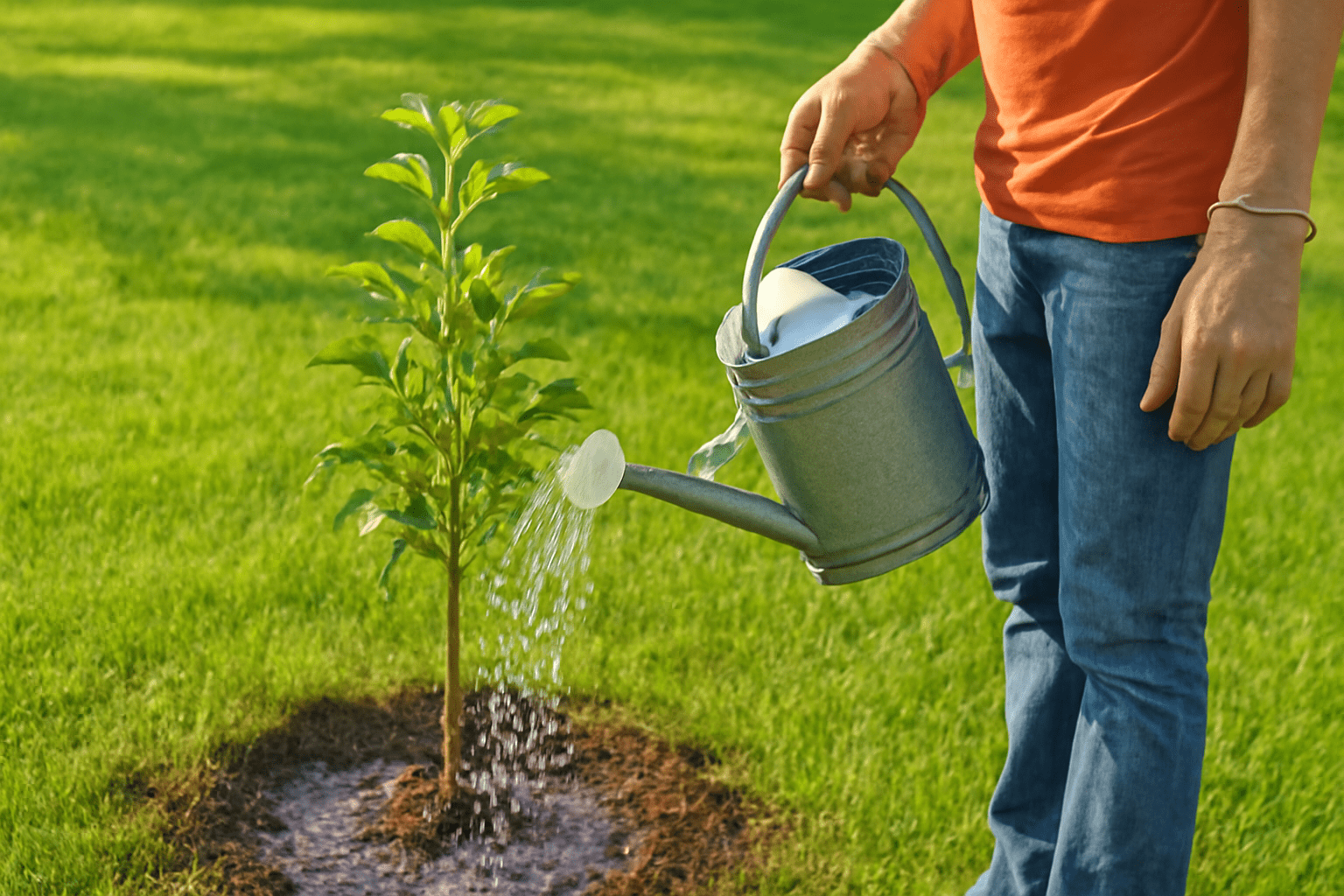
💦 Watering Schedule: How Often to Water Young Trees vs. Established Trees 🌱🌳
Watering needs vary depending on the age of your paradise apple tree. Here’s a basic guide:- Young Trees (1-3 years old): These trees need more frequent watering 💧 to help establish their root systems. Water them deeply once a week during dry spells 🌞. During the first year, you may need to water even more frequently, especially if the weather is hot 🌡️ or dry.
- Established Trees (3+ years old): Once the tree has established its roots 🌳, it requires less frequent watering 💧. Water it deeply once every 10-14 days during the growing season 🌱. Be sure to water deeply, ensuring the water reaches the root zone.
🚱 Signs of Overwatering and Underwatering: How to Recognize These Issues and Adjust 🌳
Too much or too little water can stress your paradise apple tree 🌱. Here’s how to recognize the signs and make adjustments:- Signs of Overwatering:
- Yellowing leaves 🌿, especially near the base of the tree.
- Mushy, soft soil that remains wet for long periods 🌧️.
- Root rot (can be seen as a foul smell 👃 or blackened, soft roots).
- Wilting leaves despite wet soil 💧.
- If you notice these signs, reduce watering 🚫 and improve soil drainage by adding organic matter 🌾 or adjusting irrigation systems.
- Signs of Underwatering:
- Wilting or drooping leaves 🍂, especially during hot weather 🌞.
- Dry, cracked soil around the tree 🌵.
- Leaves turning brown at the edges 🍂.
- If your tree shows these signs, increase watering 💧 and ensure the soil is being moistened to a sufficient depth. A deep watering once a week should be enough in dry weather 🌞.
💧 Drip Irrigation vs. Hand Watering: Pros and Cons of Each Method 🌿
When it comes to watering your paradise apple tree 🌳, there are two main methods to consider: drip irrigation and hand watering.- Drip Irrigation:
Pros:
- Delivers water directly to the root zone 🌱, minimizing water waste 💦.
- More efficient for watering multiple trees 🌳🌳 at once.
- Helps prevent overwatering by providing controlled water delivery 🌡️.
- Cons:
- Can be expensive to set up initially 💰.
- Requires maintenance 🧰 to ensure emitters don’t get clogged.
- Hand Watering:
Pros:
- Simple and inexpensive 💸.
- Allows you to monitor the soil moisture level more closely 👀.
- Cons:
- Time-consuming ⏰, especially for larger orchards 🌳🌳.
- Can lead to overwatering or underwatering if not done carefully 💧.
🌿 Mulching Tips: Why Mulching Around the Base Helps Retain Moisture and Prevent Weeds 🍂
Mulch is your paradise apple tree’s best friend when it comes to conserving moisture 💦 and reducing the risk of weeds 🌱. By spreading a layer of mulch (about 2-4 inches) around the base of the tree 🌳, you can:- Retain moisture: Mulch helps the soil stay cool ❄️ and prevents water from evaporating too quickly 🌞. This is especially helpful during hot summer months when trees can dry out quickly.
- Prevent weeds: By blocking sunlight ☀️, mulch prevents weeds from sprouting 🌾, so your tree doesn’t have to compete for nutrients.
- Improve soil health: As mulch decomposes, it adds organic matter to the soil 🌱, enriching it over time.
🌿 Fertilizing Your Paradise Apple Tree for Optimal Growth 🌿
Fertilizing your paradise apple tree properly is key to ensuring it grows strong, healthy, and produces a bountiful harvest. Whether you choose organic or synthetic options, knowing when and how to fertilize is just as important as selecting the right fertilizer. Let’s dive into the essentials.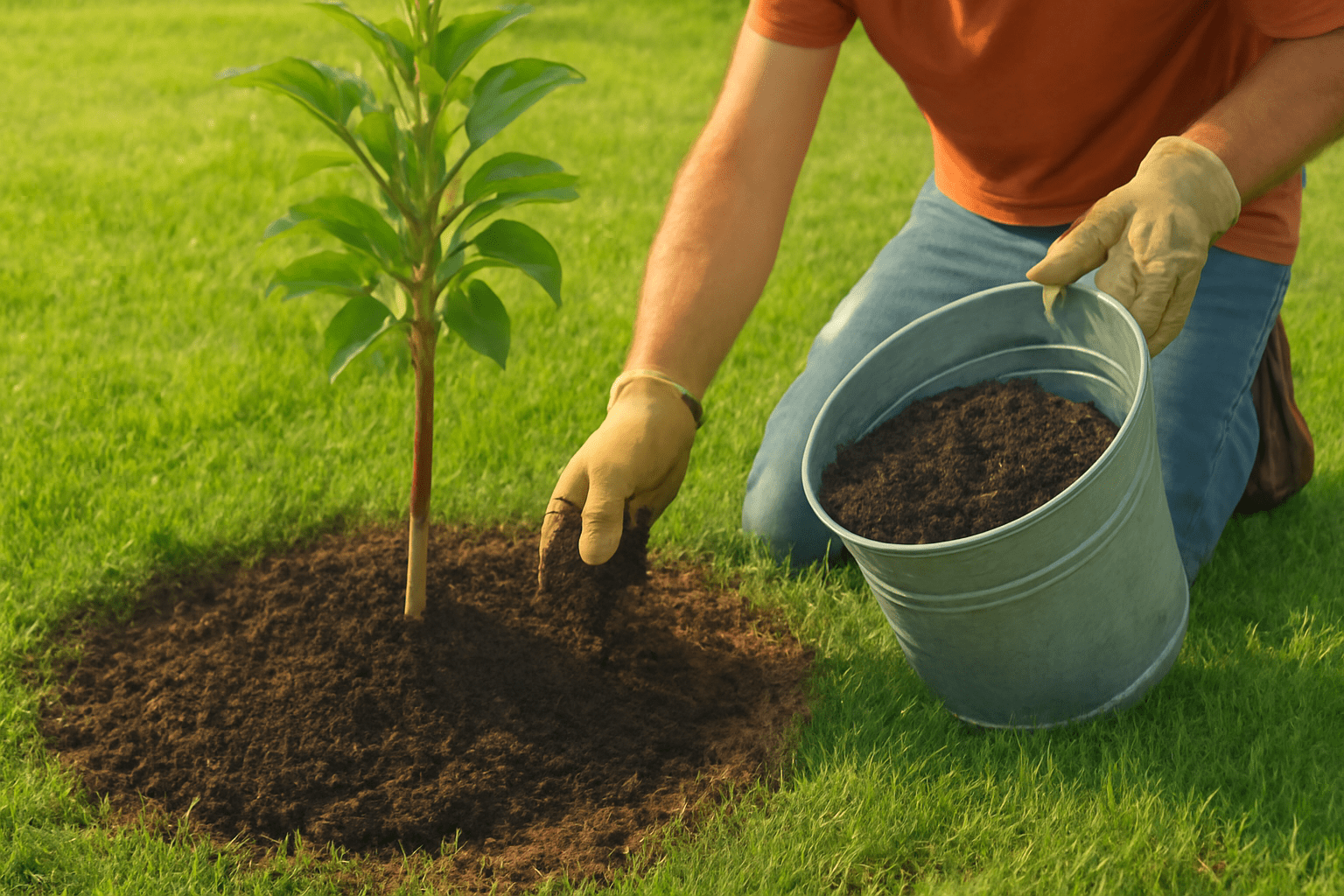
🌱 Choosing the Right Fertilizer: Organic vs. Synthetic Options
When it comes to fertilizing your paradise apple tree, you have two main options: organic or synthetic fertilizers. Each has its pros and cons.Organic Fertilizers:
Examples: Compost, well-rotted manure, bone meal, fish emulsion. Pros:- Improve soil health by adding organic matter.
- Release nutrients slowly, reducing the risk of over-fertilization.
- Better for long-term sustainability and the environment.
- Requires more time to break down and release nutrients.
- Can be more expensive than synthetic options.
Synthetic Fertilizers:
Examples: Commercial fertilizers like 10-10-10 (NPK ratio). Pros:- Provide a quick release of nutrients for immediate results.
- Easier to apply in a precise manner.
- Can harm soil health if overused.
- May lead to nutrient imbalances over time if not carefully monitored.
🗓️ Fertilizer Schedule: When and How Often to Fertilize
Knowing when and how often to fertilize your tree is crucial for optimal growth. Here’s a basic schedule to follow:Early Spring (before new growth begins):
Fertilize with a balanced fertilizer to give your tree a strong start for the growing season. Apply it just as the tree comes out of dormancy, before the new buds start forming. This helps the tree develop healthy leaves and branches. 🌱Mid-Summer (around July):
Apply a light dose of fertilizer to support fruit development. Be careful not to over-fertilize, as too much fertilizer late in the season can encourage lush growth at the expense of fruit production. 🍏 In general, it’s best to fertilize your paradise apple tree once in early spring and again in mid-summer. You can also apply compost around the base of the tree once a year to provide organic nutrients.🌾 Signs of Nutrient Deficiency: Yellowing Leaves or Poor Fruit Production
Nutrient deficiencies can hinder the growth and fruit production of your paradise apple tree. Here are some common signs to watch for:Yellowing Leaves:
If the leaves start turning yellow, particularly between the veins, your tree may be lacking nitrogen, which is vital for healthy leaf growth. Consider using a balanced nitrogen-rich fertilizer or adding compost to the soil to address this.Poor Fruit Production:
If your tree isn’t producing as many apples as expected, it could be a sign of a phosphorus or potassium deficiency, both of which are essential for fruit development. Fertilizing with a balanced, fruit-boosting fertilizer can help.Stunted Growth:
If your tree seems to grow slowly or show minimal new growth, it could be lacking in general nutrients. A slow-release balanced fertilizer with all three major nutrients (NPK: Nitrogen, Phosphorus, Potassium) will help support overall growth. Regular fertilization and paying attention to signs of nutrient deficiencies will ensure that your paradise apple tree has everything it needs to thrive and produce healthy fruit. 🌳 With the right fertilizer and a proper schedule, you’ll be well on your way to enjoying a lush, productive orchard. Let’s move on to the next step—how to prune and maintain your tree for continued success! ✂️✂️ Pruning Your Paradise Apple Tree: Keeping It Healthy and Productive ✂️
Pruning is a vital part of caring for your paradise apple tree. It helps maintain the tree’s health, encourages strong growth, and maximizes fruit production. Whether you’re a seasoned gardener or a beginner, learning the right pruning techniques will make all the difference. Here’s what you need to know:
🌸 Best Time to Prune: Early Spring Before New Growth Begins
The best time to prune your paradise apple tree is in early spring, just before the new growth begins. This timing allows you to shape the tree and remove any dead or damaged branches without disrupting the tree’s energy production. Pruning in early spring also encourages the tree to focus its energy on fresh growth and fruiting, rather than healing wounds or expelling energy on unnecessary growth. Avoid pruning in late fall or winter, as the tree is dormant during these months and may struggle to recover from pruning cuts. 🌱✂️ Basic Pruning Techniques: Removing Dead or Damaged Wood, Thinning Crowded Branches, and Shaping the Tree
Pruning is a simple process, but doing it correctly is key to your tree’s health. Here are some basic techniques to follow:Remove Dead or Damaged Wood:
Start by cutting off any dead, broken, or diseased branches. These can hinder the tree’s growth and make it more susceptible to pests or disease. Make clean cuts just above the branch collar (the swollen area where the branch meets the trunk).Thin Crowded Branches:
If the tree has multiple branches growing close together, it’s a good idea to thin them out. Thin out branches that are crossing over one another or growing inward towards the center of the tree. This improves airflow and sunlight penetration, reducing the risk of disease and ensuring better fruit production.Shape the Tree:
Aim to create a balanced, open structure with a central leader (a main trunk that is taller than the surrounding branches). The goal is to have evenly spaced branches growing outward, allowing sunlight to reach all parts of the tree. You can also cut back any long or unruly shoots to keep the tree’s shape neat and compact. 🌳🍏 Encouraging Fruit Production: How Pruning Helps the Tree Focus Energy on Fruiting
One of the most important reasons to prune your paradise apple tree is to encourage fruit production. By removing excess growth and focusing the tree’s energy on healthy branches, you help the tree concentrate its resources on producing apples, rather than maintaining unnecessary or weak growth. Pruning also improves air circulation and sunlight exposure to the inner branches, which is critical for fruit ripening. Without proper light, fruit production can be sparse, and the apples may not mature properly. In the long run, pruning helps your tree produce larger, healthier fruit with better flavor. 🍎 By following these basic pruning steps, you’ll ensure that your paradise apple tree stays healthy, productive, and beautiful for years to come. Keep in mind that pruning is an ongoing task, but with regular care, your tree will thrive and reward you with delicious apples season after season. 🌳✨ Ready to learn more about how to protect your tree from pests and diseases? Let’s move on to the next step! 🌿🐞 Pest and Disease Control: Protecting Your Tree 🐞
Keeping your paradise apple tree healthy involves protecting it from pests and diseases that can threaten its growth and fruit production. With the right knowledge and preventive measures, you can minimize the risks and ensure your tree stays strong and productive. Let’s dive into the most common pests and diseases and how to control them naturally.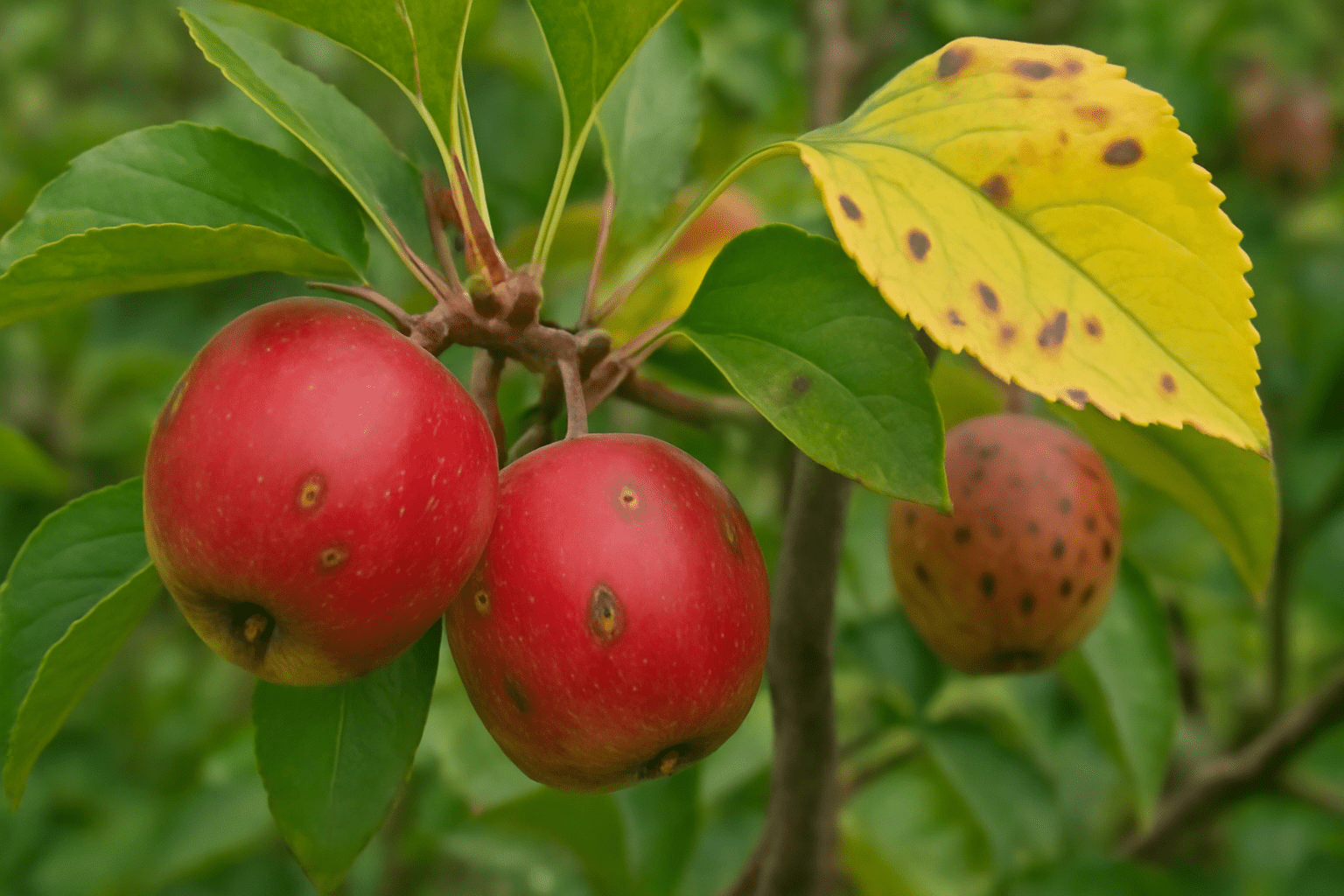
🐜 Common Pests: Aphids, Codling Moths, and Scale Insects
Pests can weaken your paradise apple tree, damage its leaves, or even ruin its fruit. Here are the most common pests to watch out for:Aphids:
These tiny insects suck sap from the tree’s leaves, causing them to curl and yellow. Aphids can also transmit diseases and attract ants. Signs:- Sticky residue on leaves (honeydew),
- Curled leaves, and
- A decrease in tree health.
Codling Moths:
These pests are notorious for ruining apple crops. The larvae burrow into apples, making them inedible. Signs:- Small holes in the fruit with brown, shriveled spots around them.
Scale Insects:
These insects attach themselves to the tree’s branches and leaves, draining nutrients. Their sticky secretions can cause the tree to weaken and become susceptible to other problems. Signs:- Small, raised bumps on branches or leaves;
- A sticky residue on leaves.
🍏 Disease Prevention: Apple Scab, Powdery Mildew, and Root Rot
Diseases can also pose a serious threat to your tree’s health. Here are a few common ones to be aware of:Apple Scab:
This fungal disease causes dark spots on leaves and fruit, leading to premature leaf drop and poor fruit quality. Prevention:- Choose disease-resistant varieties and remove fallen leaves from the ground.
- Ensure proper air circulation by thinning the tree.
Powdery Mildew:
This fungal disease appears as a white, powdery coating on leaves and new shoots, causing stunted growth and distorted leaves. Prevention:- Prune regularly to improve airflow,
- Avoid overwatering, which can promote fungal growth.
Root Rot:
Caused by waterlogged soil, root rot can weaken or kill your tree. Prevention:- Ensure proper drainage,
- Avoid overwatering.
- Consider planting your tree on a raised mound if you have heavy, clay-like soil.
🌿 Natural Pest Control: Neem Oil, Insecticidal Soap, and Companion Planting
There are many natural ways to control pests without resorting to harsh chemicals. Here are a few safe and effective options:Neem Oil:
This organic pesticide works by disrupting the feeding and breeding of insects. It’s effective against aphids, codling moths, and other pests. How to Use:- Spray the tree with neem oil during the growing season, especially when pests are first noticed.
- Make sure to coat both sides of the leaves.
Insecticidal Soap:
A mild, organic soap that targets soft-bodied insects like aphids and spider mites. How to Use:- Apply insecticidal soap in the early morning or late evening to avoid harming beneficial insects like bees.
Companion Planting:
Certain plants can naturally repel pests or attract beneficial insects. For example, planting marigolds or nasturtiums around your tree can help deter aphids, while chives can attract pollinators. By using these natural methods, you can protect your paradise apple tree from pests without harming the environment. 🌿👀 Signs of Infection or Infestation: What to Look for and How to Treat Issues Early
The key to successful pest and disease control is early detection. Here are a few signs to watch for:Wilting, Yellowing, or Discolored Leaves:
This could indicate an infection or pest infestation. Look for aphids or fungal spores on the underside of leaves.Misshapen or Damaged Fruit:
If your apples are becoming misshapen, have holes, or have dark spots, pests like codling moths may be at work.Sticky Residue on Leaves or Ground:
This is a common sign of aphids or scale insects. The sticky substance, called honeydew, can attract ants and cause further problems. If you notice any of these signs, take action immediately. Treat your tree with organic pest control methods, remove infected leaves, and maintain good tree care practices to minimize the risk of further damage. By staying vigilant and using natural pest and disease control methods, you can keep your paradise apple tree healthy and thriving. Keep your tree protected, and it will reward you with a vibrant, fruitful harvest year after year. 🌳🍏 Next up: how to harvest and store your paradise apples for the best flavor and longest shelf life! 🌟🐝 Pollination: Ensuring Fruit Production 🐝
Pollination is a crucial step in the process of growing a fruitful paradise apple tree. Whether your tree is self-pollinating or needs another variety nearby, understanding the basics of pollination will help ensure you get the best apple crop. Let’s explore everything you need to know to maximize fruit production!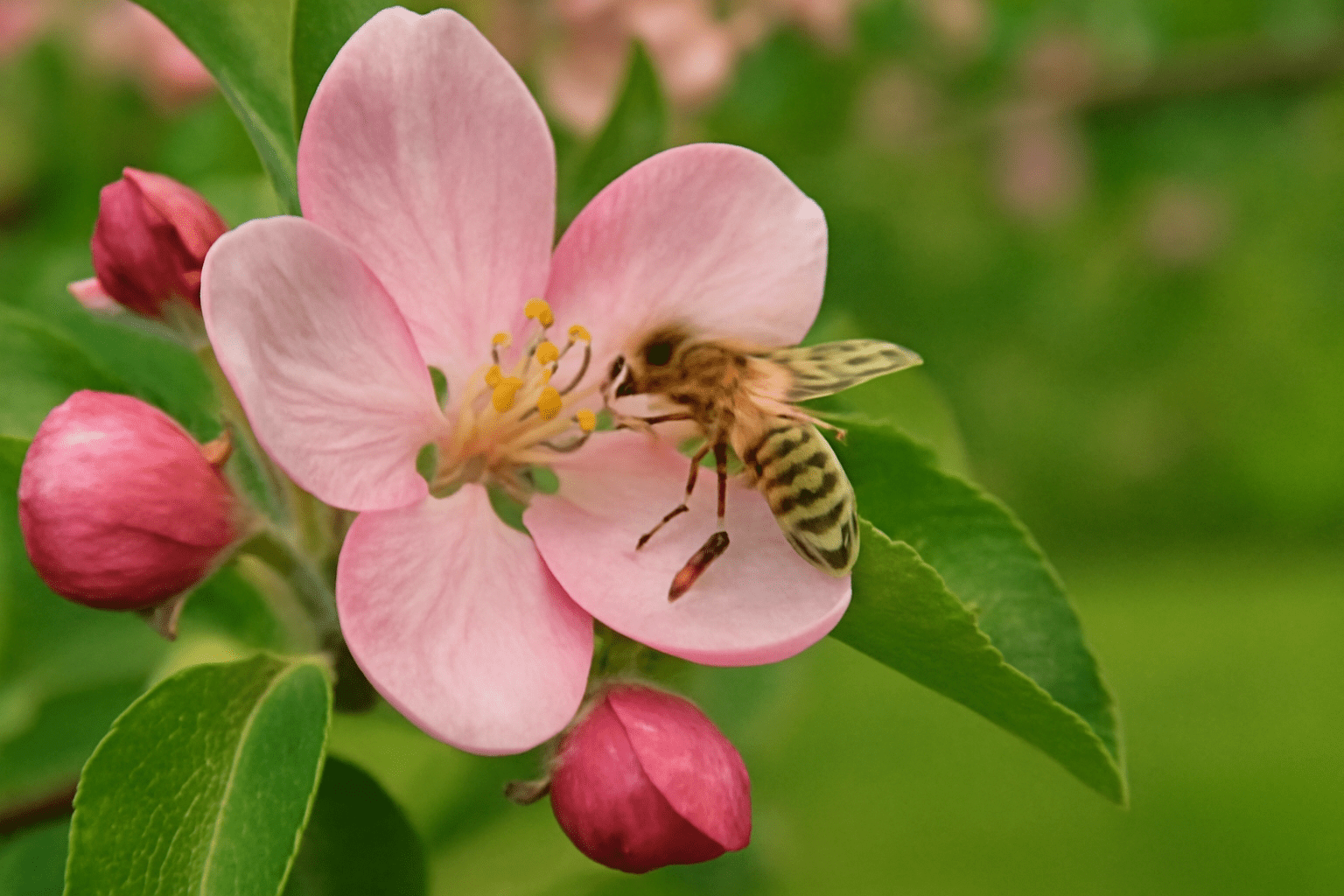
🌸 Self-Pollinating vs. Cross-Pollination: Does the Paradise Apple Tree Need Another Tree to Produce Fruit?
One of the best features of the paradise apple tree is that it is self-pollinating. This means that a single tree can produce fruit on its own without needing another tree nearby for pollination. However, while it’s not strictly necessary, cross-pollination can often improve fruit yield and quality.Self-Pollinating Trees:
The paradise apple tree produces its own pollen and can fertilize its flowers, leading to apples. If you only have room for one tree, you can still expect a healthy crop of apples!Cross-Pollination:
While not essential, planting another apple tree nearby can boost fruit production. Cross-pollination increases the genetic diversity of the apples, leading to larger, more consistent fruit and potentially higher yields. If you’re aiming for bigger harvests or better fruit, consider adding another apple variety that blooms around the same time. 🍏🍎 Choosing the Right Pollinator: Best Apple Tree Varieties for Cross-Pollination
When selecting a pollinator for your paradise apple tree, it’s important to choose an apple tree variety that blooms at the same time. Here are a few options that work well for cross-pollination:Crabapple Trees:
These small, ornamental trees are perfect for cross-pollinating with a paradise apple tree. They bloom at the same time and attract pollinators effectively.Gravenstein:
A popular apple variety that blooms in early spring, making it a good match for cross-pollination with paradise apple trees.Fuji or Gala:
If you’re looking for a variety that produces sweet apples, both Fuji and Gala apples are great choices and will cross-pollinate well with paradise apple trees. To maximize pollination, plant your second apple tree about 10-15 feet away from your paradise apple tree to ensure both trees can attract the same pollinators. 🌳🐝 Timing and Pollinator Bees: How to Encourage Bees and Other Pollinators to Visit Your Orchard
For successful pollination, you need bees and other pollinators to do their job! Here’s how to encourage pollinators to visit your paradise apple tree:Plant Bee-Friendly Flowers:
Planting flowers like lavender, sunflowers, or dandelions around your orchard can attract more bees and other beneficial insects. Bees love these plants and will be drawn to your apple trees to help with pollination.Provide Water:
Pollinators need a fresh water source. Place shallow water dishes near your tree to give them a place to drink, which will encourage them to stay close by.Avoid Pesticides:
Pesticides can harm or even kill pollinators. Opt for organic pest control methods like neem oil or insecticidal soap to keep your apple tree healthy without harming pollinators.Pollinator-Friendly Habitat:
Consider creating a habitat for pollinators by planting a variety of flowers and shrubs, leaving some areas of the garden wild, or providing bee hotels. This will help attract a steady flow of bees and insects throughout the blooming season. By encouraging pollinators, you’ll increase the chances of successful fertilization, leading to larger, more plentiful apples. 🐝🌻 Pollination is an essential part of fruit production, and with the right timing and care, your paradise apple tree will thrive. Whether you have a self-pollinating tree or are introducing a cross-pollinator, you’ll soon enjoy the sweet reward of healthy, abundant fruit! 🍏 Up next: tips on how to harvest and store your paradise apples for the best flavor and longest shelf life! 🍎🌟🍏 Harvesting and Storing Paradise Apples 🍏
After months of care, your paradise apple tree is finally ready to reward you with a delicious harvest! Knowing when to pick your apples, how to harvest them without damaging the tree, and how to store them properly is key to enjoying fresh, crisp apples throughout the season. Let’s dive into the best practices for harvesting and storing paradise apples.
🍎 When to Harvest: Signs the Apples Are Ready
The timing of your apple harvest is crucial for getting the best flavor and texture. Here’s how to tell when your paradise apples are ready for picking:Color:
When the apples reach their full color, they are typically ready to be harvested. Paradise apples usually turn a vibrant red as they ripen. The color will be more intense and uniform when the fruit is ready.Firmness:
Gently squeeze the apple to check its firmness. A ripe paradise apple will feel firm to the touch, but not rock hard. If the apple gives slightly under pressure, it’s ready to be picked.Taste:
The best way to know if your apples are ready is by tasting one! If it’s sweet and slightly tart, the apple is ripe and ready to harvest. If it still tastes too sour or bitter, give it a few more days.Separation from the Tree:
When the apples are ripe, they should come off the tree easily with a gentle twist. If you have to pull hard, the apples may not be fully ripe yet. As a general rule, paradise apples are typically ready for harvest in late summer to early fall. Depending on your climate, this can be from late August to early October. 🍂✋ How to Harvest: Gently Picking the Apples to Avoid Damaging the Tree
When it’s time to harvest, be gentle to avoid damaging the tree or the fruit. Here’s how to pick your apples carefully:Use Your Hands, Not Tools:
While it might be tempting to use a tool to grab apples from higher branches, it’s best to pick them by hand to avoid damaging the tree’s bark or branches. Gently hold the apple in your palm, give it a slight twist, and it should come off easily.Don’t Drop the Apples:
When harvesting, make sure to lower the apples gently into a basket or container. Dropping them can bruise the fruit and affect its quality.Harvest in the Morning:
It’s best to harvest your apples early in the morning when they’re cool and firm. This helps the apples last longer and preserves their crisp texture. By being gentle and picking the apples properly, you’ll avoid stress on the tree and ensure you don’t damage the fruit. 🍏🏠 Storing Apples: Best Storage Conditions to Keep Apples Fresh for Longer
Now that you’ve harvested your paradise apples, it’s time to store them properly so you can enjoy them for as long as possible. Follow these tips for optimal storage:Cool, Dry Place:
Store apples in a cool, dry, and dark area like a basement, garage, or cellar. Ideal storage temperatures are between 30-35°F (-1 to 2°C). Avoid storing apples in warm or humid environments, as they will ripen too quickly or become mushy.Separate Apples from Other Fruits:
Apples produce ethylene gas, which can cause other fruits and vegetables to ripen and spoil faster. Store apples separately from other produce to keep them fresh longer.Check for Imperfections:
Before storing, check each apple for any bruises, cuts, or signs of decay. Even a small imperfection can cause the entire batch to spoil. Only store healthy apples.Use a Crate or Box:
To prevent bruising and allow air circulation, store apples in a single layer in a wooden crate, cardboard box, or breathable bag. If you have a large quantity, you can store them in several layers, but make sure to separate them with tissue or newspaper to prevent contact between the apples.Refrigeration:
For long-term storage, apples can be placed in the fridge. Be sure to wrap them in plastic or place them in a perforated bag to maintain humidity levels. They’ll last for up to a month in the fridge, but you may want to check on them periodically for ripeness. 🧊 By following these simple storage techniques, you can enjoy the fresh, crisp taste of your paradise apples for weeks to come. If you have a large harvest, consider making apple pies, jams, or cider to preserve your apples and enjoy them all year long. 🍏🍰 With these tips on harvesting and storing your apples, you’re well on your way to enjoying a successful harvest from your paradise apple tree. Enjoy the fruits of your labor! 🌳⚠️ Troubleshooting Common Paradise Apple Tree Problems ⚠️
Even the healthiest paradise apple tree can face a few challenges. But don’t worry! Many common issues can be resolved with the right care. Here are some of the most common problems you might encounter and how to fix them.🍂 Yellowing Leaves: Possible Causes Like Nutrient Deficiencies or Pests
Yellowing leaves can be a sign that your paradise apple tree is not as healthy as it should be. Here are some possible causes and solutions:
Nutrient Deficiency:
If the leaves are yellow but the veins remain green, this could indicate a nitrogen deficiency. Nitrogen is essential for healthy leaf growth. You can address this by applying a balanced fertilizer or organic compost to boost soil nutrients.Overwatering or Poor Drainage:
Yellowing leaves can also be caused by waterlogged soil. If the roots sit in water for too long, they can suffocate and cause stress to the tree, leading to yellow leaves. Make sure the soil is well-draining and avoid overwatering. Consider adjusting your irrigation routine to ensure proper drainage.Pests:
Aphids, scale insects, and other pests can drain the sap from the leaves, causing them to yellow and curl. If you spot pests, treat your tree with neem oil or insecticidal soap to eliminate them naturally. Regularly inspect your tree for pests to catch infestations early.🍏 Poor Fruit Production: Could Be Due to Lack of Sunlight, Improper Pruning, or Pollination Issues
If your paradise apple tree isn’t producing as much fruit as expected, there are several factors to consider:Lack of Sunlight:
Apples need full sun (6-8 hours per day) to produce fruit. If your tree is in a shaded area, it may not be receiving enough sunlight to develop healthy fruit. Move the tree to a sunnier spot, if possible, or trim back any nearby trees or shrubs that might be blocking the light.Improper Pruning:
Pruning is essential for encouraging healthy growth and fruit production. If your tree is overgrown, too many branches may be competing for energy, which can reduce fruit yield. Make sure to prune your tree correctly by removing dead wood, thinning crowded branches, and focusing energy on the most productive limbs.Pollination Issues:
While paradise apple trees are self-pollinating, cross-pollination with another apple variety can boost fruit production. If you’re not getting enough apples, consider planting a compatible pollinator nearby or check if pollinators (like bees) are visiting your tree. Poor pollination could also be a sign that the tree is blooming at the wrong time or the flowers are not being properly fertilized.🌱 Wilting or Drooping: How to Identify and Fix Irrigation or Soil Problems
Wilting or drooping leaves can be a sign that your tree is not getting the right amount of water or nutrients. Here’s how to troubleshoot and fix the issue:Overwatering:
If you’ve been watering too frequently or the soil doesn’t drain properly, the roots could be suffocating, leading to wilting. Check the soil for sogginess and ensure there’s proper drainage around the root zone. Reduce watering frequency and add organic matter to improve drainage.Underwatering:
On the flip side, too little water can cause the tree to droop and wilt, especially during hot or dry periods. Check the soil moisture—if it feels dry several inches below the surface, it’s time to water. Deep watering is best, especially for young trees, to encourage strong root growth.Soil Compaction:
Sometimes, soil can become compacted, especially in clay-heavy areas, preventing water and air from reaching the roots. If you suspect soil compaction, gently aerate the soil around the tree or consider planting on a raised bed to improve root access.Pests or Disease:
Some pests, such as root-feeding nematodes, can cause wilting or drooping by damaging the roots. Similarly, fungal diseases like root rot can lead to poor root function. If pests or disease are the cause, use appropriate treatments like fungicide or nematode control to resolve the issue. By paying attention to the signs your paradise apple tree gives you, you can quickly identify problems and take action to keep your tree healthy and productive. Regular care, proper watering, and the right fertilization practices will help prevent many common issues before they arise. 🌳 If you’re dealing with any of these problems, try implementing the fixes outlined above. With the right care, your paradise apple tree will be back to thriving in no time! 🌟🌳 Final Thoughts 🌳
Growing a paradise apple tree is a rewarding experience that brings both beauty and delicious fruit to your garden. With the right care and attention, your tree can thrive and provide you with years of enjoyment, from its stunning blossoms to its crisp, sweet apples. By following the tips in this guide—from selecting the right location and planting at the right time, to pruning, watering, and managing pests—you’ll be well on your way to growing a healthy, productive paradise apple tree. Remember, the key to success is consistent care, so keep a close eye on your tree’s needs and be proactive in addressing any challenges that arise. Whether you’re a beginner gardener or an experienced grower, growing your own paradise apple tree is a truly satisfying project. Soon enough, you’ll be enjoying your own homegrown apples, and maybe even sharing them with friends and family. 🍏🍎 Happy gardening, and may your paradise apple tree flourish for many seasons to come! 🌿🌟Frequently Asked Questions (FAQ)
How long does it take for a paradise apple tree to bear fruit?
A paradise apple tree typically begins to produce fruit 3-5 years after planting, depending on its growing conditions and care. If you start with a mature tree or grafted variety, it might bear fruit a bit sooner. Be patient and ensure proper care to encourage healthy growth and fruiting.
Can I grow a paradise apple tree in a container?
Yes, you can grow a paradise apple tree in a container, especially if you have limited space. Choose a large pot with proper drainage, and ensure the tree gets enough sunlight and water. Keep in mind that container trees may need more frequent watering and may not grow as large as those planted in the ground.
Do paradise apple trees need a pollinator to produce fruit?
Paradise apple trees are self-pollinating, meaning they can produce fruit on their own. However, planting another apple variety nearby for cross-pollination can improve fruit yield and quality. Cross-pollination can lead to larger, more flavorful apples.
How do I know when my paradise apples are ready to harvest?
You’ll know your paradise apples are ready to harvest when they turn a vibrant red, feel firm to the touch, and taste slightly sweet and tart. Gently twist the apple; if it comes off the tree easily, it’s ripe. The best time to harvest is typically in late summer to early fall, depending on your climate.
What should I do if the leaves of my paradise apple tree turn yellow?
Yellowing leaves on a paradise apple tree may indicate a nutrient deficiency, especially nitrogen. It could also be caused by overwatering or pests like aphids. To fix this, adjust your watering schedule, apply a balanced fertilizer, and inspect the tree for signs of pests.
How often should I water my paradise apple tree?
Water your paradise apple tree deeply about once a week during dry spells. Young trees need more frequent watering, while established trees can go longer between waterings. Always ensure the soil is well-drained to prevent root rot, and avoid overwatering.
What pests commonly affect paradise apple trees?
Common pests that affect paradise apple trees include aphids, codling moths, and scale insects. These pests can damage leaves, stems, and fruit. Use organic treatments like neem oil or insecticidal soap to keep pests under control without harming the tree.
What is the best way to prune a paradise apple tree?
Prune your paradise apple tree in early spring, before new growth begins. Remove dead or damaged wood, thin out crowded branches, and shape the tree for better airflow and sunlight exposure. Proper pruning encourages healthy growth and more fruit production by focusing energy on the most productive branches.
